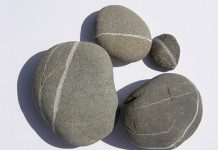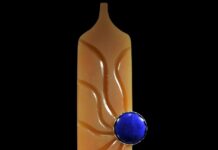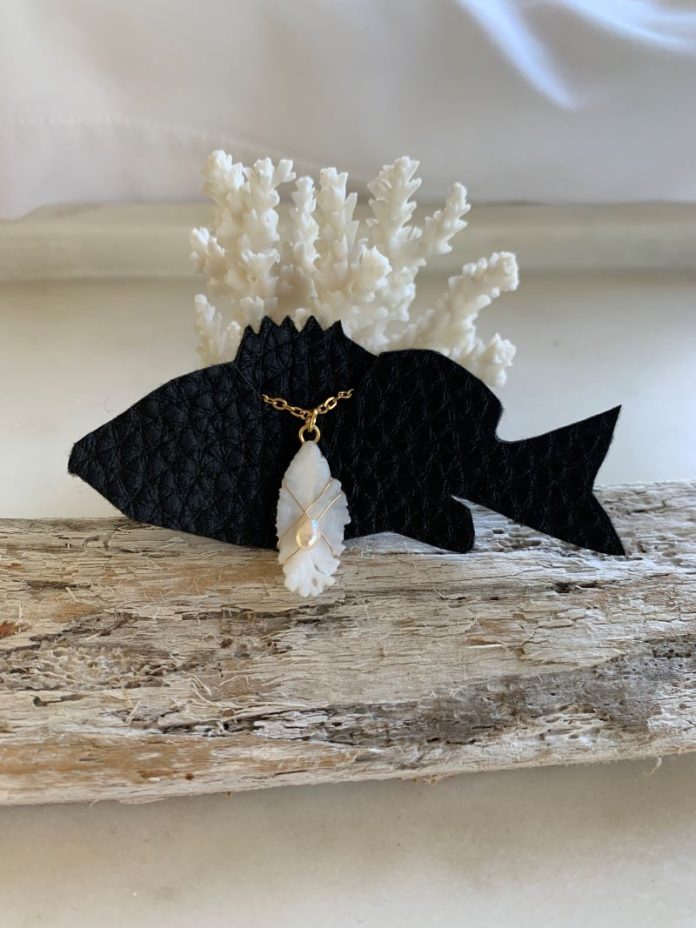
When Barry Bucciarelli hired a fishing guide in Jamaica, he noticed that the man had a pair of small white stones hanging from the boat’s overhead canopy.
“The rocks looked like two little pearls, so I asked the Wg guy what they were and why they were hanging there,” Bucciarelli recalls. “He said that the ‘rocks’ came out of the fish he caught, and they were hanging from the canopy to make sure that he had good luck every time he went fishing -I’d never see any like that before.”

According to Carol Davis of the Florida Fish and Wildlife Conservation Commission (FWCC), the small white stones were not unusual at all, and fishermen have been hanging them from their vessels for generations to have good luck. “And marine scientists have been studying them for years,” she explains.
That’s because they can help scientists understand the age of the fish, where it was found, where it lived during its lifetime and even where the fish was born.
Called otoliths, these so-called rocks or ear stones are hard calcium carbonate structures similar to chalk, limestone, eggshells, shellfish skeletons and pearls.
Generally about the size of a pea, the pearly white ear stones are located in the fish’s skull just beneath the rear of its brain but are not attached to the skull. Instead, otoliths float inside the soft, transparent inner ear canal located under the fish’s brain.
According to Grant Grisak, a biologist who studies the health, conservation and protection of fish wild populations, otoliths allow fish to “hear” sounds.
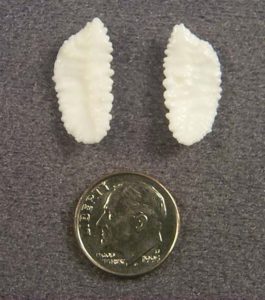 “They are how fish hear sounds – how sound resonates – and they allow (fish) to feel the vibrations in the water,” Grisak explains. “It could be compared to our inner ear.”
“They are how fish hear sounds – how sound resonates – and they allow (fish) to feel the vibrations in the water,” Grisak explains. “It could be compared to our inner ear.”
With the exception of sharks, skates and rays whose skeletons are composed of cartilage, all fish have otoliths inside their heads. Different species have between one and three pairs of them of varying shapes and sizes.
The shape of the otolith is so distinctive that scientists who study wildlife have found them in the stomachs and droppings of seals and birds allowing them to determine what kind of fish they ate, and its size before the predator ate it, according to the FWCC.
Generally, the larger the size of the ear stones the larger the fish, Grisak says.
“Lake Trout for example may be eight years old and only grow to eight inches long,” he explains. “By contrast a Black Drum fish found in the North Atlantic Ocean off North America’s east coast may be very large, have very large otoliths and live to 70 or 80 years old.”
There are three types of otoliths – one large pair called the sagittae and two smaller pairs called the lapilli and the asteriscii that are tiny – about the size of the tip of a pin.
Fish biologists derive the otoliths they study by obtaining fish heads from fishermen or by catching their own fish to study. “You can see them (scientists from the FWCC) out here every weekend,” says Donald Harris, operator of Blue Collar Fishing Charters in Ruskin, Florida.
Grisak says the fish heads are collected at fish cleaning stations located around the favorite spots of fishermen near freshwater lakes or, as is Harris’ case, around Florida’s saltwater fishing destinations.
Either way, the fish must be dead for their otoliths to be harvested.
“This is a necrotic activity for the fish,” he quips.
However they are obtained, it’s the larger pair of otoliths that biologists use to determine a fish’s age. Meanwhile, the smallest pair – the lapilli – when viewed under a microscope helps scientists record how a fish ages on a daily basis.
According to Grisak, scientists use refracted light from a microscope to view the growth rings called annuli that are seen as darker spots on the otoliths. “Like the rings of a tree,” he says.
 A fish’s age is determined in part by how closely those rings are together.
A fish’s age is determined in part by how closely those rings are together.
“When the fish’s growth is slow, the annuli get closer together,” Grisak explains. Old age and the beginning of sexual maturity can slow a fish’s growth. So can scarcity in its diet.
When it’s cut in half, an otolith’s cross-section reveals every layer of its creation from its beginning to the time of its harvest.
Scientists study the stone’s core to determine where the fish was hatched and where it lived its life.
“We can determine where they breed, and it’s important for us to track migration patterns of the fish,” Grisak says.
It also figures significantly in conservation efforts when scientists study the concentration of elements and isotopes found in otoliths to determine the condition of the waters in which the fish lives to determine its movements.
According to the FWCC’s Carol Davis, fisheries biologists also use that information not only to manage conditions in fisheries but also for their efforts to conserve the environment of fish that live in the wild.
“It (the information) is important for us to preserve the fish’s habitat,” Grisak points out.
In fact, according to Grisak, some scientists have studied otoliths more than 170 million years old to learn how the environment including diet, lifespan and water temperature of wild fish changed over time.
But otoliths have more than scientific value, according to Catherine Yronwode, operator of the Lucky Mojo Curio Company in Forestville, California.
According to the company’s website, Native Americans polished the otoliths derived from the fish they caught and attached them to their canoes to ensure that their future catches were bountiful. They also carried the pearl-like ear stones in pouches for good luck and sewed them as decoration onto clothing.
These days, these “charm stones” are carried in someone’s pocket to attract luck, success in business, and even love. They are especially thought to bring luck to prostitutes and woman gamblers, the company’s website claims.
“Also, some people polish them (the otoliths) to make earrings, necklaces and other jewelry,” Grisak says.
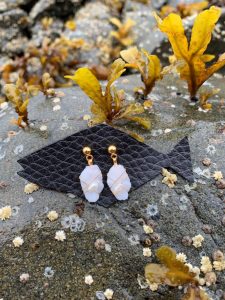 One of those people is Magdalena Lee owner, operator and jewelry designer for Salmon Seas Jewelry which offers a complete line of designs that feature otoliths derived from fish caught in California and Alaska.
One of those people is Magdalena Lee owner, operator and jewelry designer for Salmon Seas Jewelry which offers a complete line of designs that feature otoliths derived from fish caught in California and Alaska.
“I visit the commercial fishing piers when I am in California and Alaska and take the otoliths out myself,” says Lee who is also an avid angler. “I wash them off, dry them and sort them because no two are alike.”
Once the “stones” are sorted, Lee wraps them in wire to create her designs.
“I’m inspired by fine jewelry, and I’m on my knees over a bucket finding the right otoliths for my designs.”
Aside from the scientists and the jewelers, otoliths are probably most prized by fishermen who carry the stones to curry the favors of the fates to boost their odds of netting dinner or landing a record-sized catch.
Bucciarelli says he’s harvested a few otoliths himself and hung them near the wheel of his boat.
“I don’t know how much luck they’ve brought me, but I’m not taking any chances,” he admits, “At the very least, they’re nice little trophies.”
As for Lee, she has some experience with the more magical aspects assigned to the otoliths as well.
“I had one order for a customer that bounced back because the address wasn’t right,” Lee recalls. “So I did some research and when the search came back the address was for the Bunny Ranch – that’s the legal brothel in Nevada – I thought, well, that’s interesting!”
This story about otoliths previously appeared in Rock & Gem magazine. Click here to subscribe. Story by Pat Raia.




